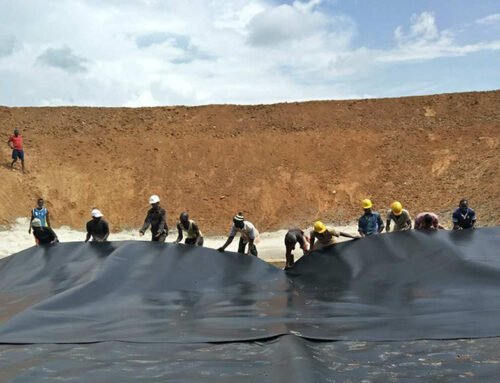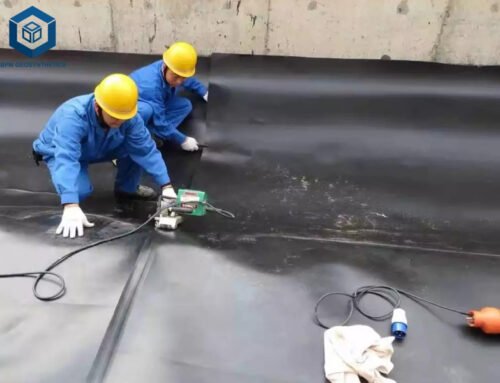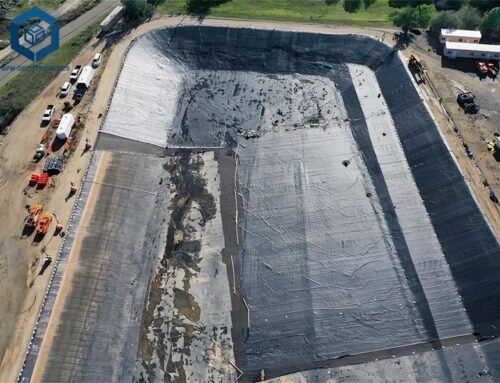Composite geomembrane is a multi-layered geomembrane that combines different materials, such as geotextile, geotechnical net, and geomaterial, to enhance its anti-seepage capabilities and load-bearing capacity. As a reputable manufacturer and supplier of geomembranes, BPM Geomembrane offers a comprehensive selection of geomembrane liner products. Our geomembranes are available in various sizes, thicknesses, and configurations, allowing for customization to suit specific project requirements. We take pride in providing high-quality geomembranes at competitive factory prices, ensuring that our customers receive reliable and cost-effective solutions for their containment and waterproofing needs.
Composite Geomembrane is type of geomembrane liner which is the optimal choice for enhanced frictional and waterproof performance. BPM Geomemrbane offers composite liner in custom thickness and size.
1. What Is A Composite Geomembrane?
Composite geomembrane is a versatile and effective solution used for anti-seepage purposes in various civil engineering and environmental applications. It is composed of multiple layers of different materials, typically including geotextile and geomembrane liners, which are bonded together to create a high-performance barrier.
The primary purpose of composite geomembrane is to prevent the seepage or leakage of liquids or gases, providing an impermeable barrier for containment systems. By combining different materials in its construction, composite geomembrane offers enhanced anti-seepage capabilities and improved load-bearing capacity.
The geotextile layer in the composite geomembrane provides reinforcement and filtration functions. It helps distribute load and reduces the risk of punctures or damage to the geomembrane layer. The geotextile also acts as a filter, allowing for the passage of water while retaining finer particles, preventing clogging and maintaining the long-term effectiveness of the system.
The geomembrane liner layer is the core component of the composite geomembrane. It is responsible for providing the primary impermeable barrier, preventing the migration of liquids or gases through the structure. The geomembrane liner is typically made of high-density polyethylene (HDPE), which offers excellent chemical resistance, durability, and long-term performance.
BPM Geomembrane is a trusted manufacturer and supplier of high-quality geomembranes, including composite geomembrane products. We offer a wide range of options in terms of size, thickness, and configuration, allowing for customization to meet the specific requirements of each project. Our geomembranes undergo rigorous quality control processes to ensure their reliability and performance.
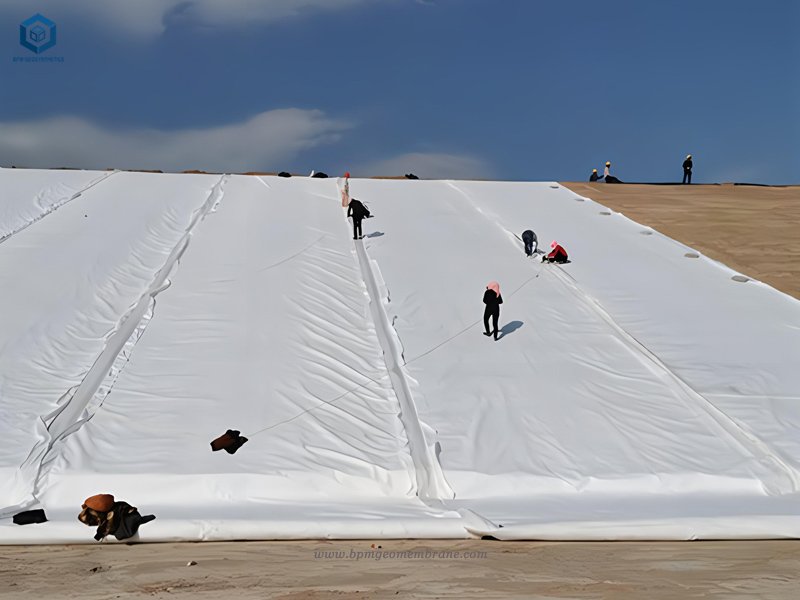
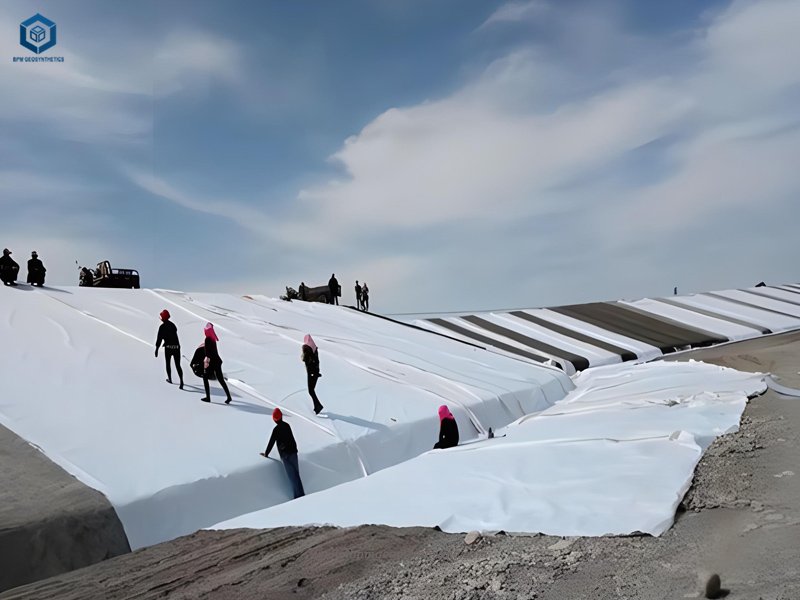
2. What Are Applications of Composite Geomembrane
Composite geomembranes have a wide range of applications in various engineering fields due to their excellent anti-seepage properties and durability. Some of the main applications include:
2.1 Anti-Seepage Engineering
Composite geomembranes are extensively used in anti-seepage projects. They are installed on soil or rock foundations to prevent the infiltration of water, oil, chemicals, and pollutants into the groundwater or surrounding environment. These projects find application in water conservancy, metallurgy, chemical industry, and construction sectors.
2.2 Leakage Prevention Engineering
Composite geomembranes are employed in leakage prevention projects to create a barrier against water and air penetration. They are applied on building surfaces or water bodies to effectively prevent leaks and maintain the integrity of structures. This application is commonly seen in large buildings, reservoirs, sewage treatment plants, and similar facilities.
2.3 Isolation Protection Engineering
Composite geomembranes serve as an effective solution for isolation protection. They are used in landfills to isolate waste materials and prevent pollution from seeping into the surrounding environment. By acting as a barrier, composite geomembranes ensure the containment of hazardous substances, safeguarding ecosystems and human health.
Composite geomembranes can be utilized in other applications such as pond liners, canal lining, mining operations, agricultural water storage, and environmental remediation projects. Their versatility, strength, and resistance to chemical degradation make them suitable for various scenarios that require reliable containment and anti-seepage measures.
Composite geomembranes play a crucial role in maintaining the integrity of structures, protecting the environment from contamination, and ensuring the efficient management of water resources and waste materials. Their widespread use in diverse industries highlights their effectiveness and importance in modern engineering practices.
3. How To Manufacture Best Composite Geomembrane
Compared with the single-layer geomembrane, the composite geomembrane has better mechanical properties and seepage prevention effect, and can meet the more stringent engineering requirements. The production engineering of this material mainly has the following six steps:
3.1 Material Selection
Choose the appropriate polymer material, usually using high-density polyethylene (HDPE) or polypropylene (PP).
3.2 Extrusion membrane preparation
The selected polymer material is added to the extruder, extrusion at high temperature and high pressure, to form a continuous geotechnical sheet through the extrusion outlet.
3.3 Compound treatment
The extruded geomembrane is combined with other functional layers to enhance its performance. These functional layers may include materials such as non-woven fabrics, fiber mesh, and fit on both sides of the extrusion membrane.
3.4 Thermal pressure finishing
after composite treatment, the geomembrane needs to be thermal pressing finishing, so that its surface becomes smooth and smooth, and ensure the close union between the layers.
3.5 Testing and screening
Test the prepared geomembranes to ensure that the product quality meets the relevant standards. Unqualified products will be screened out.
3.6 Packaging and storage
Screened composite geomembrane, cut in length and width, packaged and identified. Finally stored in a dry, ventilated and protected warehouse.
4. How To Classify Composite Geomembranes?
There are many ways to classify the composite geomembrane. According to the different number of composite layers, the composite geomembrane can be divided into three kinds: one cloth and one membrane, two cloth and one membrane and three cloth and two membranes. A cloth and a membrane refers to a single layer of composite geomembrane composed of a layer of geomembrane and a layer of nonwoven material (or fiber material), which is usually used in the field of seepage prevention, isolation and protection. Two cloth and one membrane refers to the double layer composite geomembrane is composed of two layers of geomembrane and a layer of nonwoven material (or fiber material), which is usually used in groundwater pollution control, dam, tunnel and other fields. Among them, the double layer of geomembrane between the two layers of geomembrane is usually sandwiched with a layer of polyethylene film, to enhance the seepage performance. It consists of three layers of geotextile and two layers of geomembrane, and is usually used in land improvement, seepage prevention and reinforcement fields. Play the role of strengthening the strength and stability of the soil. Two membrane refers to the laying of a layer of geomembrane on both sides of the three cloth, to play the role of seepage prevention and isolation. Such composite geomembrane seepage control system has good seepage resistance, durability and impact resistance, and is widely used in land improvement, water conservancy engineering, landscaping and other fields.
Composite geomembrane is divided into two types according to the length of composite fiber: long fiber composite geomembrane and short fiber composite geomembrane. Short fiber geomembrane is a geotextile material made of polyethylene as the main raw material, adding glass fiber, polyester fiber, absorbing fiber and other reinforcing materials through high temperature fusion of polyethylene. Its thickness is generally between 0.2mm-3mm, the width is generally 4m, the length can be customized according to the demand.
Pros:
- Corrosion resistance: it can be used in a sour and alkaline environment for a long time without corrosion.
- Good weather resistance: in the extreme high and low temperature and strong ultraviolet light environment, its performance changes are also very small.
- Anti-seepage effect: the anti-seepage performance of this geomembrane is very good, which can be used in the soil layer with the groundwater level up to 20m, and has a good anti-seepage effect.
Cons:
- High price: compared with other geosynthetics, the price of short fiber geomembrane is higher.
- Difficult construction: Due to its thin thickness and easy to damage, the construction needs a high technical difficulty.
- Silk geomembrane
Filament geomembrane is a geotechnical material made of polyester as the main raw material and adding glass fiber, carbon fiber and other reinforcing materials through spinning stretching. Its thickness is generally between 0.15mm-1.5mm, the width is generally 6m, the length can be customized according to the requirements.
Pros:
- The price is relatively low: compared with the short fiber geomembrane, its price is relatively low.
- Good anti-seepage effect: the filament geomembrane has good anti-seepage effect, which can be used to prevent bottom leakage and crack leakage.
- Good corrosion resistance and oxidation resistance.
Cons:
- Suscely susceptible to chemicals: filament geomembrane will be affected by acid and alkali, if used in a weakly alkaline environment, its life will be greatly shortened.
- Difficult construction: compared with short fiber geomembrane, the construction of filament geomembrane is more difficult, which requires more strict construction technology.
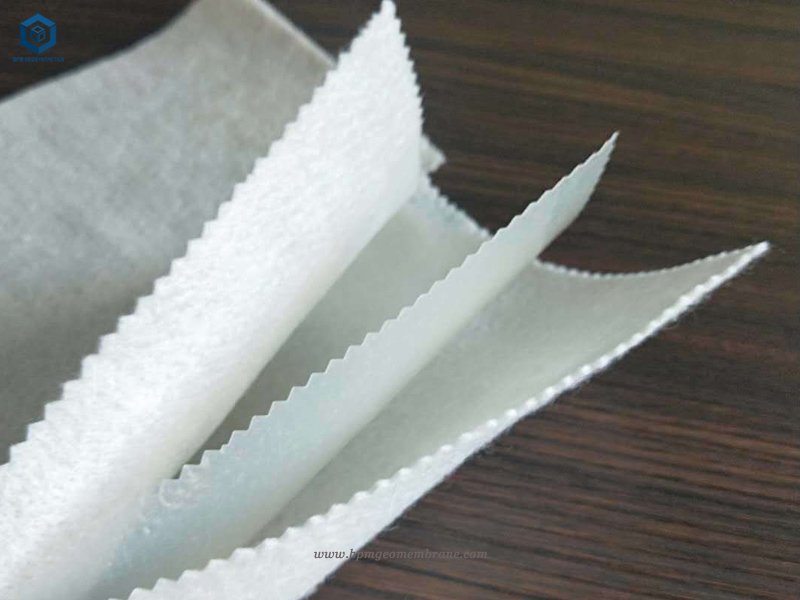
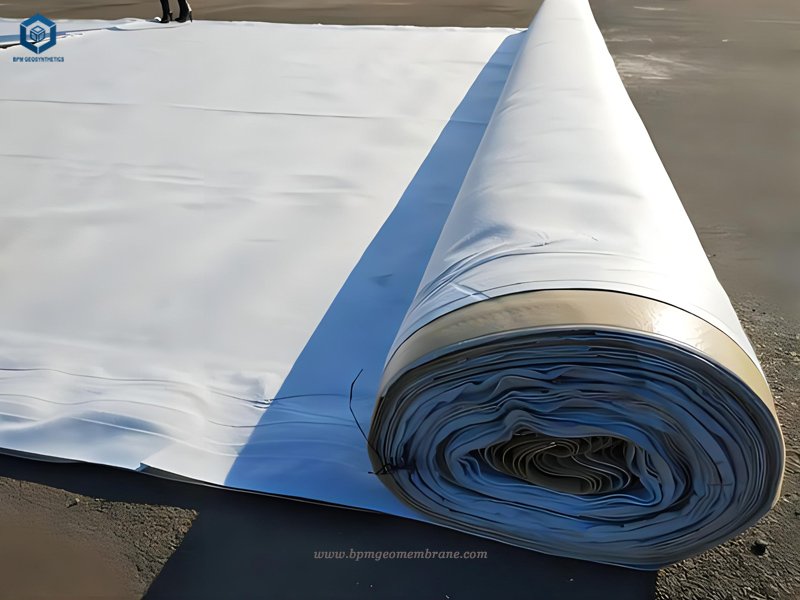
5. What Are Advantages of Composite Geomembrane?
Compared with the traditional waterproof materials, the advantages of composite geomembrane are mainly reflected in the following aspects:
- Good waterproof performance: the composite geomembrane has excellent waterproof performance, and can effectively prevent the penetration of water, oil, pollutants and other substances, to ensure the safety and health of the environment.
- Corrosion resistance and aging resistance: the composite geomembrane adopts a multi-layer composite structure, which has the characteristics of corrosion resistance and aging resistance, and can be used in different natural environments.
- Convenient construction: the composite geomembrane has a certain flexibility and plasticity, can be cut and laid according to the need, with a certain construction convenience.
- Economic and practical: compared with traditional waterproof materials, composite geomembrane has the advantages of high cost performance and low cost, which can effectively reduce the engineering cost.


